2007 INFINITI QX56 lock
[x] Cancel search: lockPage 1070 of 3061

REAR VIEW MONITOR
DI-59
< SERVICE INFORMATION >
C
D
E
F
G
H
I
J
L
MA
B
DI
N
O
P
• to rear view camera control unit terminal 1.
When ignition switch is in ACC or ON position, power is supplied
• through 10A fuse [No. 4, located in the fuse block (J/B)]
• to rear view camera control unit terminal 2.
Ground is supplied
• to rear view camera control unit terminal 3 and
• to rear view camera terminal 2
• through grounds B7 and B19.
AV COMMUNICATION LINE
Rear view camera control unit is connected to the following units with AV communication line. Each unit trans-
mits/receives data with AV communication line.
• NAVI control unit
• Display unit
• Display control unit
• AV switch
REAR VIEW CAMERA OPERATION
When ignition switch is in ON or START position, power is supplied
• through 10A fuse (No. 51, located in the IPDM E/R)
• to back-up lamp relay terminals 1 and 3.
When A/T selector lever is in reverse position, power is supplied
• through back-up lamp relay terminal 2
• to TCM terminal 7.
Then, when back-up lamp relay is energized,
• from back-up lamp relay terminal 5
• to rear view camera control unit terminal 4.
Then, rear view camera control unit is sent camera ON signal
• through rear view camera control unit terminal 8
• to rear view camera terminal 1.
An image taken by rear view camera is sent
• through rear view camera terminals 3 and 4
• to rear view camera control unit terminals 10 and 9.
Then an image is sent
• through rear view camera control unit terminals 11 and 12
• to display unit terminals 4 and 15.
An image of rear view will be projected on the display.
Side Distance Guideline
When A/T selector lever is in reverse position, rear view camera control unit is sent rear view camera guideline
image
• through rear view camera control unit terminals 11 and 12
• to display unit terminals 4 and 15.
Rear view camera guideline will be projected on the display.
Display shows image from rear view camera image and rear view camera guideline.
Page 1095 of 3061

EC-12
< SERVICE INFORMATION >
INDEX FOR DTC
*1: 1st trip DTC No. is the same as DTC No.
*2: This number is prescribed by SAE J2012.
*3: In Diagnostic Test Mode II (Self-diagnostic results), this number is controlled by NISSAN.
*4: The troubleshooting for this DTC needs CONSULT-II.
*5: When the fail-safe operations for both self-diagnoses occur, the MIL illuminates.
*6: 2WD models
*7: Models with ICC
Alphabetical IndexINFOID:0000000003531579
NOTE:
•If DTC U1000 or U1001 is displayed with other DTC, first perform the trouble diagnosis for DTC
U1000, U1001. Refer to EC-145
.
P1568 1568
ICC COMMAND VALUE*7EC-519
P1572 1572 ASCD BRAKE SWEC-520 (Models with ICC)
EC-528
(Models with ASCD)
P1574 1574
ASCD VHL SPD SEN*
6EC-535 (Models with ICC)
EC-537
(Models with ASCD)
P1610 - P1615 1610 - 1615 NATS MALFUNCTIONBL-116
P1710 1710 ATF TEMP SEN/CIRCAT- 11 9
P1730 1730 A/T INTERLOCKAT- 1 2 6
P1752 1752 I/C SOLENOID/CIRCAT- 1 3 0
P1754 1754 I/C SOLENOID FNCTNAT- 1 3 2
P1757 1757 FR/B SOLENOID/CIRCAT- 1 3 4
P1759 1759 FR/B SOLENOID FNCTAT- 1 3 6
P1762 1762 D/C SOLENOID/CIRCAT- 1 3 8
P1764 1764 D/C SOLENOID FNCTNAT- 1 4 0
P1767 1767 HLR/C SOL/CIRCAT- 1 4 2
P1769 1769 HLR/C SOL FNCTNAT- 1 4 4
P1772 1772 LC/B SOLENOID/CIRCAT- 1 4 6
P1774 1774 LC/B SOLENOID FNCTAT- 1 4 8
P1805 1805 BRAKE SW/CIRCUITEC-539
P2100 2100 ETC MOT PWREC-543
P2101 2101 ETC FUNCTION/CIRCEC-548
P2103 2103 ETC MOT PWREC-543
P2118 2118 ETC MOTEC-554
P2119 2119 ETC ACTREC-559
P2122 2122 APP SEN 1/CIRCEC-561
P2123 2123 APP SEN 1/CIRCEC-561
P2127 2127 APP SEN 2/CIRCEC-567
P2128 2128 APP SEN 2/CIRCEC-567
P2135 2135 TP SENSOREC-574
P2138 2138 APP SENSOREC-581
P2A00 2A00 A/F SENSOR1 (B1)EC-588
P2A03 2A03 A/F SENSOR1 (B2)EC-588
DTC*1
Items
(CONSULT-II screen terms)Reference page
CONSULT-II
GST*
2ECM*3
Page 1096 of 3061
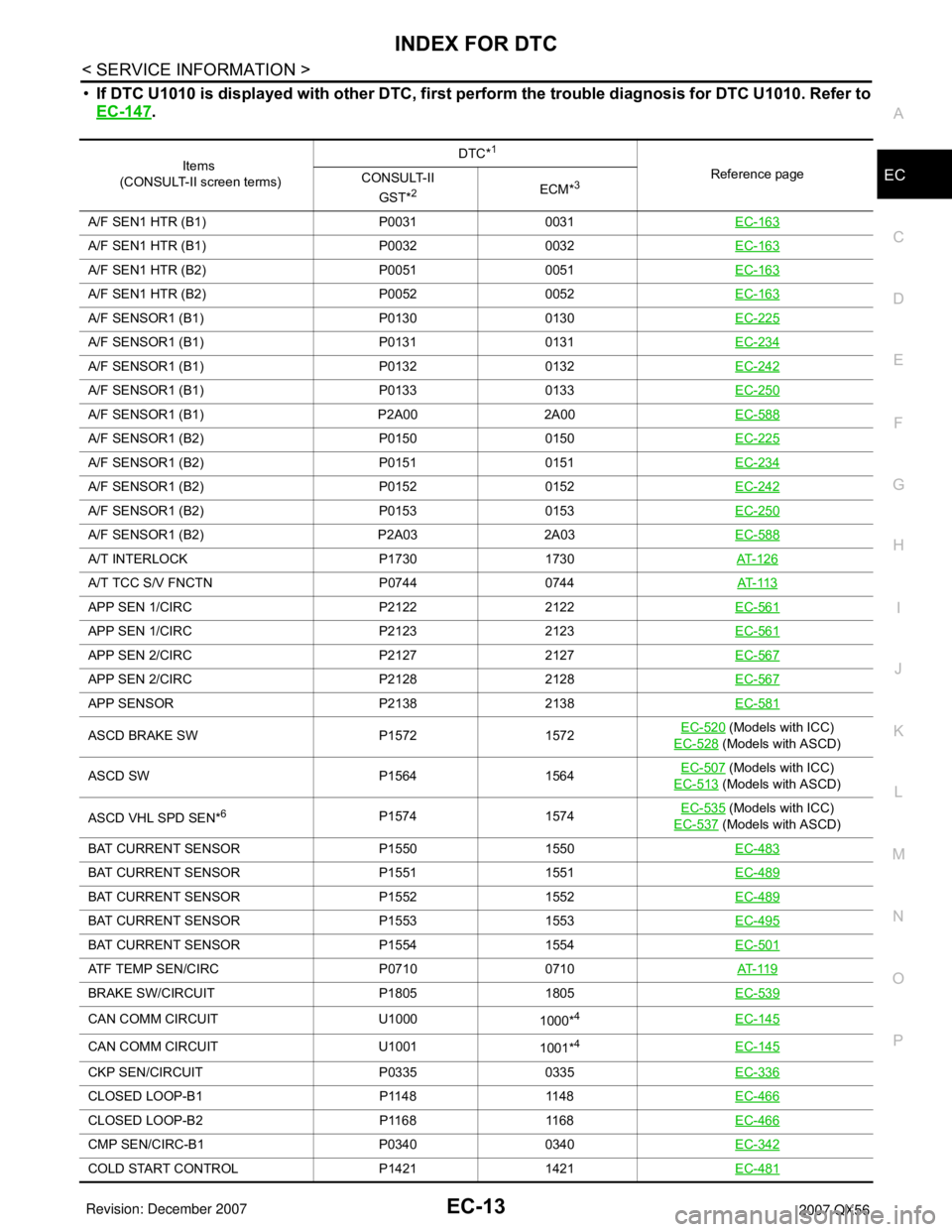
INDEX FOR DTC
EC-13
< SERVICE INFORMATION >
C
D
E
F
G
H
I
J
K
L
MA
EC
N
P O
•If DTC U1010 is displayed with other DTC, first perform the trouble diagnosis for DTC U1010. Refer to
EC-147
.
Items
(CONSULT-II screen terms)DTC*
1
Reference page
CONSULT-II
GST*
2ECM*3
A/F SEN1 HTR (B1) P0031 0031EC-163
A/F SEN1 HTR (B1) P0032 0032EC-163
A/F SEN1 HTR (B2) P0051 0051EC-163
A/F SEN1 HTR (B2) P0052 0052EC-163
A/F SENSOR1 (B1) P0130 0130EC-225
A/F SENSOR1 (B1) P0131 0131EC-234
A/F SENSOR1 (B1) P0132 0132EC-242
A/F SENSOR1 (B1) P0133 0133EC-250
A/F SENSOR1 (B1) P2A00 2A00EC-588
A/F SENSOR1 (B2) P0150 0150EC-225
A/F SENSOR1 (B2) P0151 0151EC-234
A/F SENSOR1 (B2) P0152 0152EC-242
A/F SENSOR1 (B2) P0153 0153EC-250
A/F SENSOR1 (B2) P2A03 2A03EC-588
A/T INTERLOCK P1730 1730AT- 1 2 6
A/T TCC S/V FNCTN P0744 0744AT- 11 3
APP SEN 1/CIRC P2122 2122EC-561
APP SEN 1/CIRC P2123 2123EC-561
APP SEN 2/CIRC P2127 2127EC-567
APP SEN 2/CIRC P2128 2128EC-567
APP SENSOR P2138 2138EC-581
ASCD BRAKE SW P1572 1572EC-520 (Models with ICC)
EC-528
(Models with ASCD)
ASCD SW P1564 1564EC-507
(Models with ICC)
EC-513
(Models with ASCD)
ASCD VHL SPD SEN*
6P1574 1574EC-535 (Models with ICC)
EC-537
(Models with ASCD)
BAT CURRENT SENSOR P1550 1550EC-483
BAT CURRENT SENSOR P1551 1551EC-489
BAT CURRENT SENSOR P1552 1552EC-489
BAT CURRENT SENSOR P1553 1553EC-495
BAT CURRENT SENSOR P1554 1554EC-501
ATF TEMP SEN/CIRC P0710 0710AT- 11 9
BRAKE SW/CIRCUIT P1805 1805EC-539
CAN COMM CIRCUIT U1000
1000*4EC-145
CAN COMM CIRCUIT U1001
1001*4EC-145
CKP SEN/CIRCUIT P0335 0335EC-336
CLOSED LOOP-B1 P1148 1148EC-466
CLOSED LOOP-B2 P1168 1168EC-466
CMP SEN/CIRC-B1 P0340 0340EC-342
COLD START CONTROL P1421 1421EC-481
Page 1100 of 3061
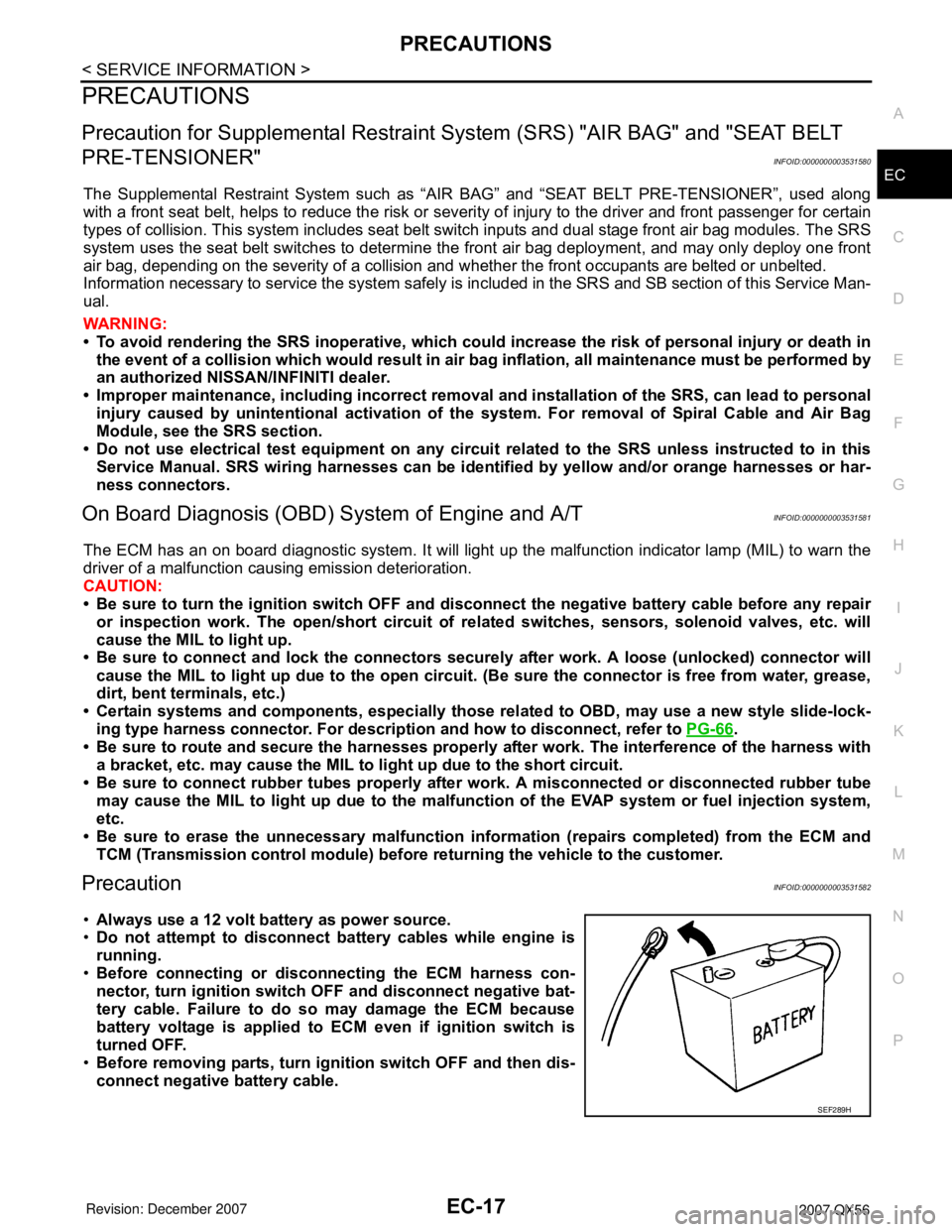
PRECAUTIONS
EC-17
< SERVICE INFORMATION >
C
D
E
F
G
H
I
J
K
L
MA
EC
N
P O
PRECAUTIONS
Precaution for Supplemental Restraint System (SRS) "AIR BAG" and "SEAT BELT
PRE-TENSIONER"
INFOID:0000000003531580
The Supplemental Restraint System such as “AIR BAG” and “SEAT BELT PRE-TENSIONER”, used along
with a front seat belt, helps to reduce the risk or severity of injury to the driver and front passenger for certain
types of collision. This system includes seat belt switch inputs and dual stage front air bag modules. The SRS
system uses the seat belt switches to determine the front air bag deployment, and may only deploy one front
air bag, depending on the severity of a collision and whether the front occupants are belted or unbelted.
Information necessary to service the system safely is included in the SRS and SB section of this Service Man-
ual.
WARNING:
• To avoid rendering the SRS inoperative, which could increase the risk of personal injury or death in
the event of a collision which would result in air bag inflation, all maintenance must be performed by
an authorized NISSAN/INFINITI dealer.
• Improper maintenance, including incorrect removal and installation of the SRS, can lead to personal
injury caused by unintentional activation of the system. For removal of Spiral Cable and Air Bag
Module, see the SRS section.
• Do not use electrical test equipment on any circuit related to the SRS unless instructed to in this
Service Manual. SRS wiring harnesses can be identified by yellow and/or orange harnesses or har-
ness connectors.
On Board Diagnosis (OBD) System of Engine and A/TINFOID:0000000003531581
The ECM has an on board diagnostic system. It will light up the malfunction indicator lamp (MIL) to warn the
driver of a malfunction causing emission deterioration.
CAUTION:
• Be sure to turn the ignition switch OFF and disconnect the negative battery cable before any repair
or inspection work. The open/short circuit of related switches, sensors, solenoid valves, etc. will
cause the MIL to light up.
• Be sure to connect and lock the connectors securely after work. A loose (unlocked) connector will
cause the MIL to light up due to the open circuit. (Be sure the connector is free from water, grease,
dirt, bent terminals, etc.)
• Certain systems and components, especially those related to OBD, may use a new style slide-lock-
ing type harness connector. For description and how to disconnect, refer to PG-66
.
• Be sure to route and secure the harnesses properly after work. The interference of the harness with
a bracket, etc. may cause the MIL to light up due to the short circuit.
• Be sure to connect rubber tubes properly after work. A misconnected or disconnected rubber tube
may cause the MIL to light up due to the malfunction of the EVAP system or fuel injection system,
etc.
• Be sure to erase the unnecessary malfunction information (repairs completed) from the ECM and
TCM (Transmission control module) before returning the vehicle to the customer.
PrecautionINFOID:0000000003531582
•Always use a 12 volt battery as power source.
•Do not attempt to disconnect battery cables while engine is
running.
•Before connecting or disconnecting the ECM harness con-
nector, turn ignition switch OFF and disconnect negative bat-
tery cable. Failure to do so may damage the ECM because
battery voltage is applied to ECM even if ignition switch is
turned OFF.
•Before removing parts, turn ignition switch OFF and then dis-
connect negative battery cable.
SEF289H
Page 1119 of 3061
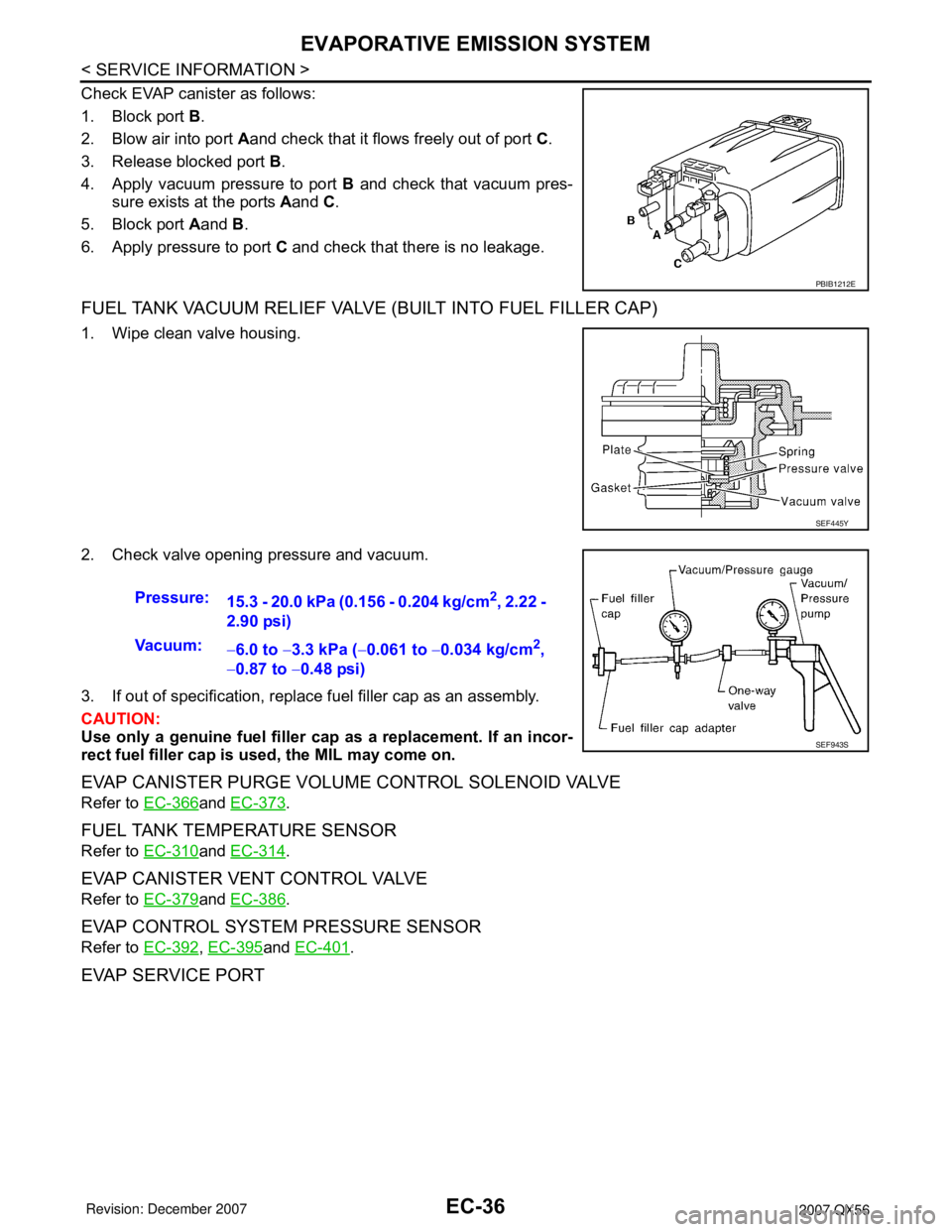
EC-36
< SERVICE INFORMATION >
EVAPORATIVE EMISSION SYSTEM
Check EVAP canister as follows:
1. Block port B.
2. Blow air into port Aand check that it flows freely out of port C.
3. Release blocked port B.
4. Apply vacuum pressure to port B and check that vacuum pres-
sure exists at the ports Aand C.
5. Block port Aand B.
6. Apply pressure to port C and check that there is no leakage.
FUEL TANK VACUUM RELIEF VALVE (BUILT INTO FUEL FILLER CAP)
1. Wipe clean valve housing.
2. Check valve opening pressure and vacuum.
3. If out of specification, replace fuel filler cap as an assembly.
CAUTION:
Use only a genuine fuel filler cap as a replacement. If an incor-
rect fuel filler cap is used, the MIL may come on.
EVAP CANISTER PURGE VOLUME CONTROL SOLENOID VALVE
Refer to EC-366and EC-373.
FUEL TANK TEMPERATURE SENSOR
Refer to EC-310and EC-314.
EVAP CANISTER VENT CONTROL VALVE
Refer to EC-379and EC-386.
EVAP CONTROL SYSTEM PRESSURE SENSOR
Refer to EC-392, EC-395and EC-401.
EVAP SERVICE PORT
PBIB1212E
SEF445Y
Pressure:
15.3 - 20.0 kPa (0.156 - 0.204 kg/cm2, 2.22 -
2.90 psi)
Vacuum:
−6.0 to −3.3 kPa (−0.061 to −0.034 kg/cm
2,
−0.87 to −0.48 psi)
SEF943S
Page 1120 of 3061
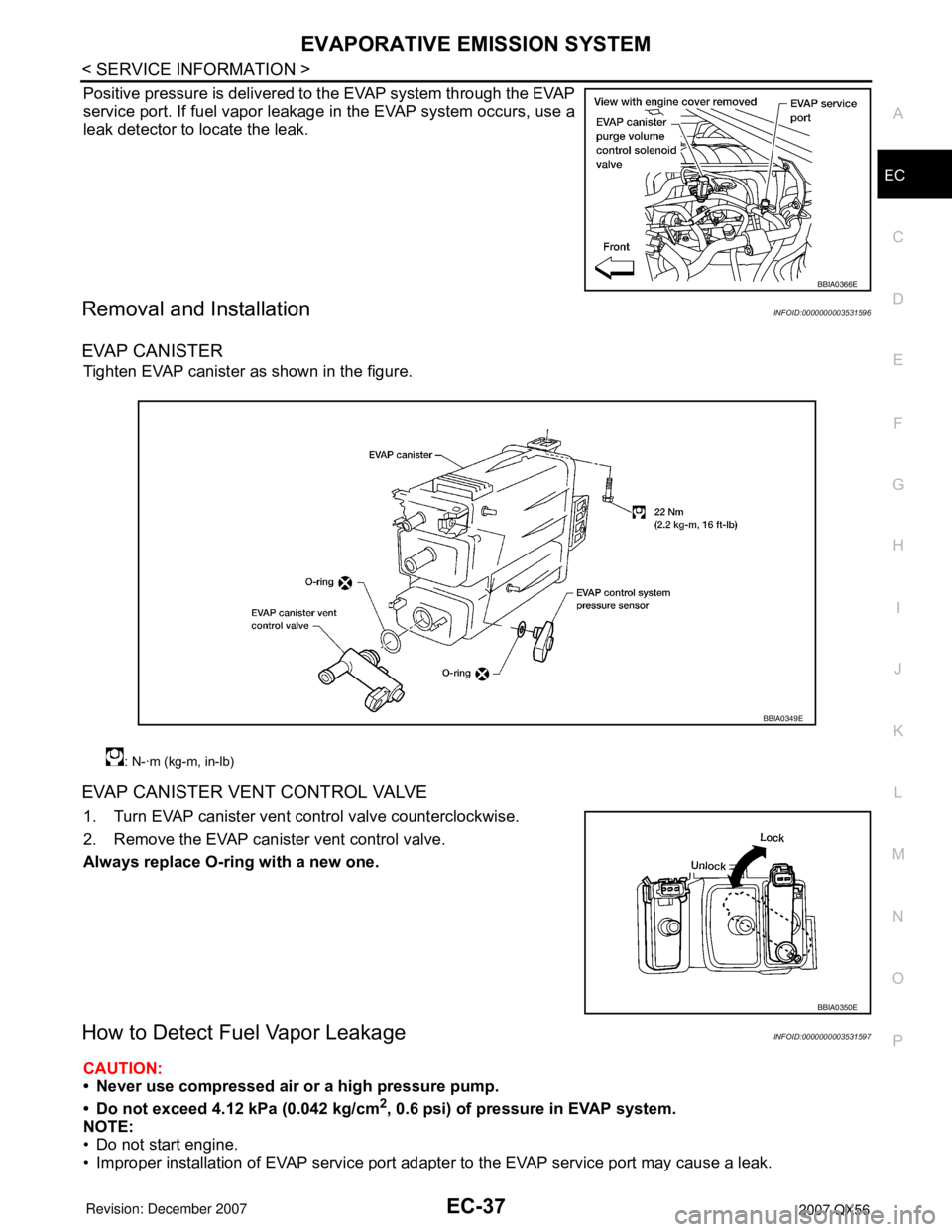
EVAPORATIVE EMISSION SYSTEM
EC-37
< SERVICE INFORMATION >
C
D
E
F
G
H
I
J
K
L
MA
EC
N
P O
Positive pressure is delivered to the EVAP system through the EVAP
service port. If fuel vapor leakage in the EVAP system occurs, use a
leak detector to locate the leak.
Removal and InstallationINFOID:0000000003531596
EVAP CANISTER
Tighten EVAP canister as shown in the figure.
EVAP CANISTER VENT CONTROL VALVE
1. Turn EVAP canister vent control valve counterclockwise.
2. Remove the EVAP canister vent control valve.
Always replace O-ring with a new one.
How to Detect Fuel Vapor LeakageINFOID:0000000003531597
CAUTION:
• Never use compressed air or a high pressure pump.
• Do not exceed 4.12 kPa (0.042 kg/cm
2, 0.6 psi) of pressure in EVAP system.
NOTE:
• Do not start engine.
• Improper installation of EVAP service port adapter to the EVAP service port may cause a leak.
BBIA0366E
: N-·m (kg-m, in-lb)
BBIA0349E
BBIA0350E
Page 1135 of 3061
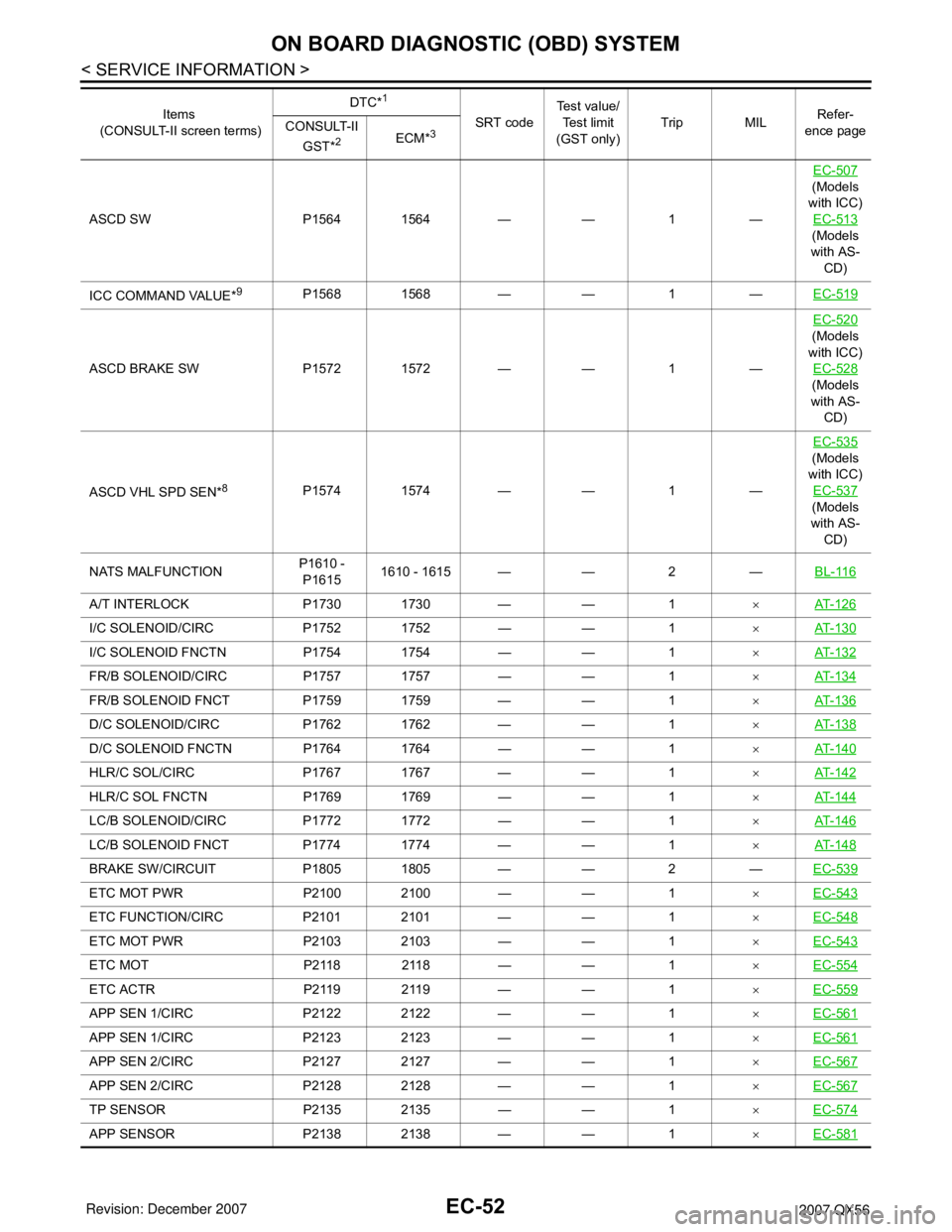
EC-52
< SERVICE INFORMATION >
ON BOARD DIAGNOSTIC (OBD) SYSTEM
ASCD SW P1564 1564 — — 1 —EC-507
(Models
with ICC)
EC-513
(Models
with AS-
CD)
ICC COMMAND VALUE*
9P1568 1568 — — 1 —EC-519
ASCD BRAKE SW P1572 1572 — — 1 —EC-520
(Models
with ICC)
EC-528
(Models
with AS-
CD)
ASCD VHL SPD SEN*
8P1574 1574 — — 1 —EC-535
(Models
with ICC)
EC-537
(Models
with AS-
CD)
NATS MALFUNCTIONP1610 -
P16151610 - 1615 — — 2 —BL-116
A/T INTERLOCK P1730 1730 — — 1×AT- 1 2 6
I/C SOLENOID/CIRC P1752 1752 — — 1×AT- 1 3 0
I/C SOLENOID FNCTN P1754 1754 — — 1×AT- 1 3 2
FR/B SOLENOID/CIRC P1757 1757 — — 1×AT- 1 3 4
FR/B SOLENOID FNCT P1759 1759 — — 1×AT- 1 3 6
D/C SOLENOID/CIRC P1762 1762 — — 1×AT- 1 3 8
D/C SOLENOID FNCTN P1764 1764 — — 1×AT- 1 4 0
HLR/C SOL/CIRC P1767 1767 — — 1×AT- 1 4 2
HLR/C SOL FNCTN P1769 1769 — — 1×AT- 1 4 4
LC/B SOLENOID/CIRC P1772 1772 — — 1×AT- 1 4 6
LC/B SOLENOID FNCT P1774 1774 — — 1×AT- 1 4 8
BRAKE SW/CIRCUIT P1805 1805 — — 2 —EC-539
ETC MOT PWR P2100 2100 — — 1×EC-543
ETC FUNCTION/CIRC P2101 2101 — — 1×EC-548
ETC MOT PWR P2103 2103 — — 1×EC-543
ETC MOT P2118 2118 — — 1×EC-554
ETC ACTR P2119 2119 — — 1×EC-559
APP SEN 1/CIRC P2122 2122 — — 1×EC-561
APP SEN 1/CIRC P2123 2123 — — 1×EC-561
APP SEN 2/CIRC P2127 2127 — — 1×EC-567
APP SEN 2/CIRC P2128 2128 — — 1×EC-567
TP SENSOR P2135 2135 — — 1×EC-574
APP SENSOR P2138 2138 — — 1×EC-581
Items
(CONSULT-II screen terms)DTC*
1
SRT codeTest value/
Test limit
(GST only)Trip MILRefer-
ence page CONSULT-II
GST*
2ECM*3
Page 1147 of 3061
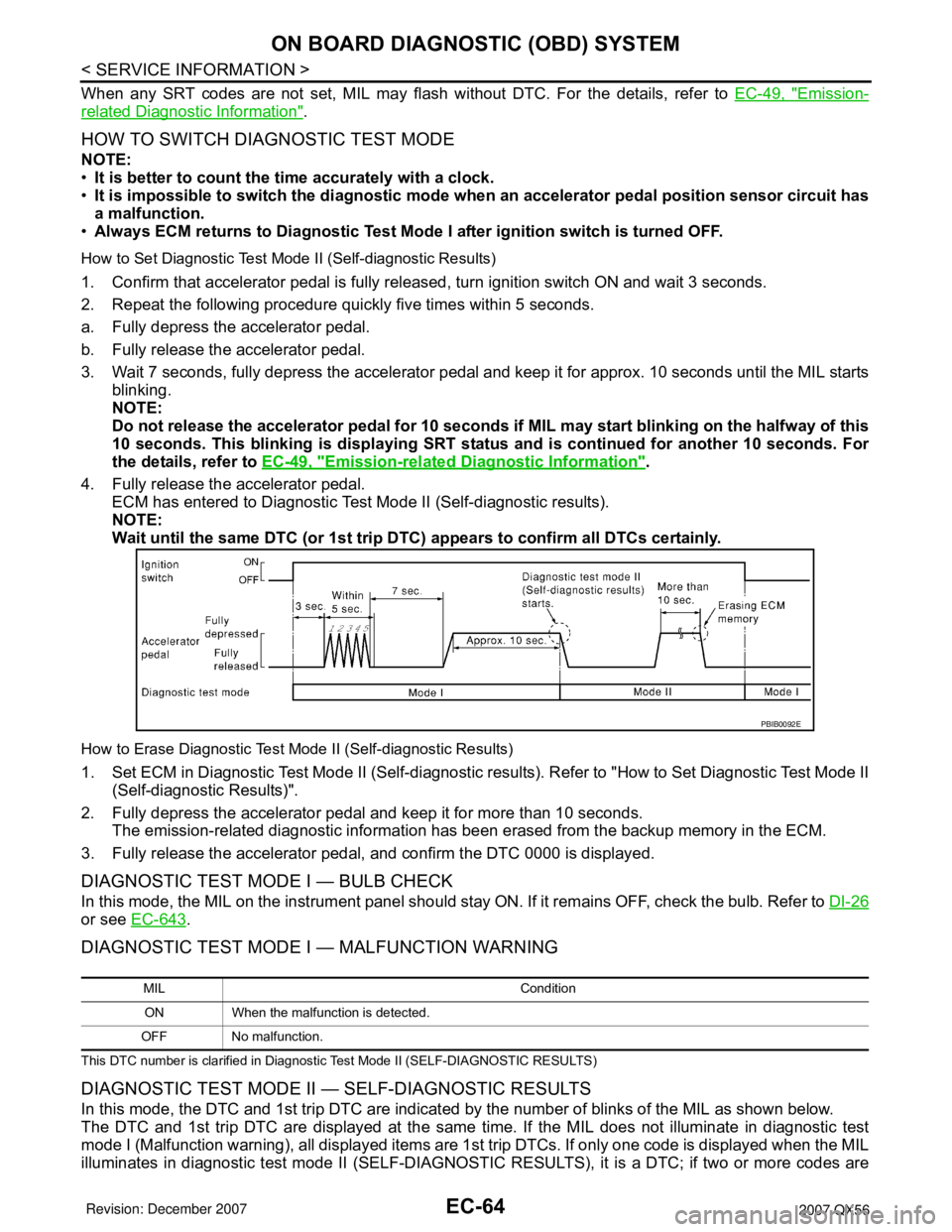
EC-64
< SERVICE INFORMATION >
ON BOARD DIAGNOSTIC (OBD) SYSTEM
When any SRT codes are not set, MIL may flash without DTC. For the details, refer to EC-49, "Emission-
related Diagnostic Information".
HOW TO SWITCH DIAGNOSTIC TEST MODE
NOTE:
•It is better to count the time accurately with a clock.
•It is impossible to switch the diagnostic mode when an accelerator pedal position sensor circuit has
a malfunction.
•Always ECM returns to Diagnostic Test Mode I after ignition switch is turned OFF.
How to Set Diagnostic Test Mode II (Self-diagnostic Results)
1. Confirm that accelerator pedal is fully released, turn ignition switch ON and wait 3 seconds.
2. Repeat the following procedure quickly five times within 5 seconds.
a. Fully depress the accelerator pedal.
b. Fully release the accelerator pedal.
3. Wait 7 seconds, fully depress the accelerator pedal and keep it for approx. 10 seconds until the MIL starts
blinking.
NOTE:
Do not release the accelerator pedal for 10 seconds if MIL may start blinking on the halfway of this
10 seconds. This blinking is displaying SRT status and is continued for another 10 seconds. For
the details, refer to EC-49, "
Emission-related Diagnostic Information".
4. Fully release the accelerator pedal.
ECM has entered to Diagnostic Test Mode II (Self-diagnostic results).
NOTE:
Wait until the same DTC (or 1st trip DTC) appears to confirm all DTCs certainly.
How to Erase Diagnostic Test Mode II (Self-diagnostic Results)
1. Set ECM in Diagnostic Test Mode II (Self-diagnostic results). Refer to "How to Set Diagnostic Test Mode II
(Self-diagnostic Results)".
2. Fully depress the accelerator pedal and keep it for more than 10 seconds.
The emission-related diagnostic information has been erased from the backup memory in the ECM.
3. Fully release the accelerator pedal, and confirm the DTC 0000 is displayed.
DIAGNOSTIC TEST MODE I — BULB CHECK
In this mode, the MIL on the instrument panel should stay ON. If it remains OFF, check the bulb. Refer to DI-26
or see EC-643.
DIAGNOSTIC TEST MODE I — MALFUNCTION WARNING
This DTC number is clarified in Diagnostic Test Mode II (SELF-DIAGNOSTIC RESULTS)
DIAGNOSTIC TEST MODE II — SELF-DIAGNOSTIC RESULTS
In this mode, the DTC and 1st trip DTC are indicated by the number of blinks of the MIL as shown below.
The DTC and 1st trip DTC are displayed at the same time. If the MIL does not illuminate in diagnostic test
mode I (Malfunction warning), all displayed items are 1st trip DTCs. If only one code is displayed when the MIL
illuminates in diagnostic test mode II (SELF-DIAGNOSTIC RESULTS), it is a DTC; if two or more codes are
PBIB0092E
MIL Condition
ON When the malfunction is detected.
OFF No malfunction.